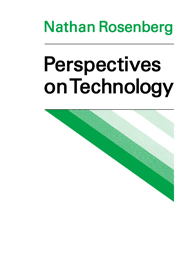Book contents
- Frontmatter
- Contents
- Acknowledgments
- Introduction
- Part 1 Some origins of American technology
- Part 2 The generation of new technologies
- Part 3 Diffusion and adaptation of technology
- 8 Capital goods, technology, and economic growt
- 9 Economic development and the transfer of technology: some historical perspectives
- 10 Selection and adaptation in the transfer of technology: steam and iron in America 1800-1870
- 11 Factors affecting the diffusion of technology
- Part 4 Natural resources, environment and the growth of knowledge
- Epilogue
- Notes
- Index
8 - Capital goods, technology, and economic growt
Published online by Cambridge University Press: 09 January 2010
- Frontmatter
- Contents
- Acknowledgments
- Introduction
- Part 1 Some origins of American technology
- Part 2 The generation of new technologies
- Part 3 Diffusion and adaptation of technology
- 8 Capital goods, technology, and economic growt
- 9 Economic development and the transfer of technology: some historical perspectives
- 10 Selection and adaptation in the transfer of technology: steam and iron in America 1800-1870
- 11 Factors affecting the diffusion of technology
- Part 4 Natural resources, environment and the growth of knowledge
- Epilogue
- Notes
- Index
Summary
One of the things which we all “know” about American economic history is that the relative scarcity of labor in the United States has led to the development of our well-known, much-admired laborsaving technology. But why, in underdeveloped countries, with abundant supplies of labor and scarce capital, has not the scarcity of capital led to the development of capital-saving techniques?
It is at once apparent that there is a confusion with respect to what we all “know” about American economic history – or, at least, that there is a highly important distinction which is typically glossed over. Scarcity of labor has, in the United States, resulted in the adoption of labor-saving techniques, just as, in underdeveloped countries, the abundance of labour has led to the adoption of labor-intensive, capital-saving techniques. So far there is complete symmetry in our treatment. Differences with respect to factor endowment, and therefore with respect to factor prices, dictate different optimum techniques along an existing production function.
What is frequently asserted with respect to American economic development is an additional and much more important proposition, namely that labor scarcity has in fact led to the development of a new, labor-saving technology, to shifts in the production function, and not merely to movements along an existing production function in accordance with factor endowment and prices. But, on reflection, it appears reasonable to ask why this should be the case only when it is labor which is scarce, and not capital.
- Type
- Chapter
- Information
- Perspectives on Technology , pp. 141 - 150Publisher: Cambridge University PressPrint publication year: 1976
- 1
- Cited by



